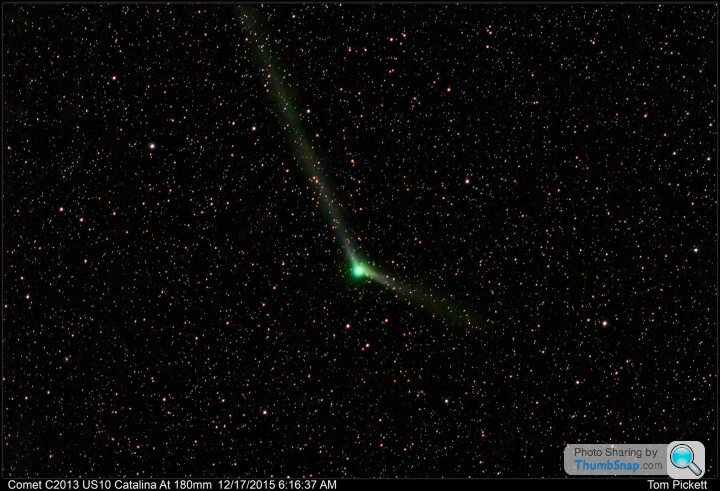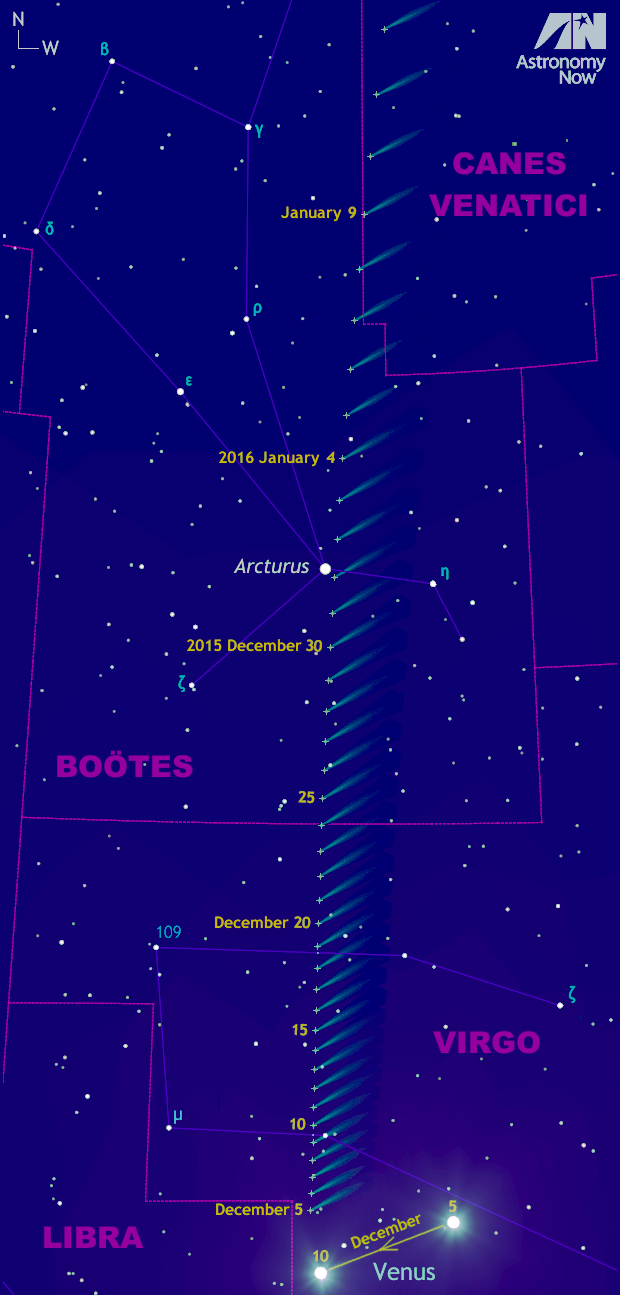Comet Catalina
Discussion
Heads up on a comet now becoming visible in the East just before dawn...
http://www.universetoday.com/123511/its-finally-he...
http://www.universetoday.com/123511/its-finally-he...
Tom Pickett posted this pic of the comet on Facebook tonight

"Hi Everyone... I hope you are having a good day.. smile emoticon
This morning I got up and went after Comet C2013 US10 Catalina At 180mm. I love it, there is so much detail.. smile emoticon
have a good day and clear skies
Details
C/2013 US10 (Catalina) is an Oort cloud comet discovered on 31 October 2013 by the Catalina Sky Survey at an apparent magnitude of 19 using a 0.68-meter (27 in) Schmidt–Cassegrain telescope. As of September 2015 the comet is around apparent magnitude 6.
When discovered on 31 October 2013 observations from another object from 12 September 2013 were used in the preliminary orbit determination giving an incorrect solution that suggested an orbital period of only 6 years. But by 6 November 2014 a longer observation arc from 14 August until 4 November made it apparent that the first solution had the wrong object from 12 September.
By early May 2015 the comet could be around apparent magnitude 12 and will have an elongation of 60 degrees from the Sun as it moves further into the southern hemisphere. The comet will come to solar conjunction on 6 November 2015 when the comet might be around magnitude 5. The comet will come to perihelion (closest approach to the Sun) on 15 November 2015 at a distance of 0.82 AU from the Sun. At perihelion, it will have a velocity of 46.4 km/s (104,000 mph) with respect to the Sun which is slightly greater than the Sun's escape velocity at that distance. It crosses the celestial equator on 17 December 2015 becoming a northern hemisphere object. On 17 January 2016 the comet will pass 0.72 AU (108,000,000 km; 67,000,000 mi) from Earth and could still be around magnitude 5 while located in the constellation of Ursa Major.
C/2013 US10 is dynamically new. It came from the Oort cloud with a loosely bound chaotic orbit that was easily perturbed by galactic tides and passing stars. Before entering the planetary region (epoch 1950), C/2013 US10 had an orbital period of several million years. After leaving the planetary region (epoch 2050), it will be on an ejection trajectory.
Equipment Details
Camera: Canon EOS T3i/600D (Un-Modified)
Lens: Canon 75-300mm set at 180mm F5.0
Exposure: 3inutes ( 180 Seconds) Each
ISO: 1600
Number of Light Frames: 9
Number of Dark Frames: 9
Number of Bias Frames: 9
Mount: Celestron CG4 with Clock Drive
Stacking Software: DeepSkyStacker
Processing Software: Photoshop CS6, Camera Raw
Shooting Date/Time 12/17/2015 6:16:37 AM"

"Hi Everyone... I hope you are having a good day.. smile emoticon
This morning I got up and went after Comet C2013 US10 Catalina At 180mm. I love it, there is so much detail.. smile emoticon
have a good day and clear skies
Details
C/2013 US10 (Catalina) is an Oort cloud comet discovered on 31 October 2013 by the Catalina Sky Survey at an apparent magnitude of 19 using a 0.68-meter (27 in) Schmidt–Cassegrain telescope. As of September 2015 the comet is around apparent magnitude 6.
When discovered on 31 October 2013 observations from another object from 12 September 2013 were used in the preliminary orbit determination giving an incorrect solution that suggested an orbital period of only 6 years. But by 6 November 2014 a longer observation arc from 14 August until 4 November made it apparent that the first solution had the wrong object from 12 September.
By early May 2015 the comet could be around apparent magnitude 12 and will have an elongation of 60 degrees from the Sun as it moves further into the southern hemisphere. The comet will come to solar conjunction on 6 November 2015 when the comet might be around magnitude 5. The comet will come to perihelion (closest approach to the Sun) on 15 November 2015 at a distance of 0.82 AU from the Sun. At perihelion, it will have a velocity of 46.4 km/s (104,000 mph) with respect to the Sun which is slightly greater than the Sun's escape velocity at that distance. It crosses the celestial equator on 17 December 2015 becoming a northern hemisphere object. On 17 January 2016 the comet will pass 0.72 AU (108,000,000 km; 67,000,000 mi) from Earth and could still be around magnitude 5 while located in the constellation of Ursa Major.
C/2013 US10 is dynamically new. It came from the Oort cloud with a loosely bound chaotic orbit that was easily perturbed by galactic tides and passing stars. Before entering the planetary region (epoch 1950), C/2013 US10 had an orbital period of several million years. After leaving the planetary region (epoch 2050), it will be on an ejection trajectory.
Equipment Details
Camera: Canon EOS T3i/600D (Un-Modified)
Lens: Canon 75-300mm set at 180mm F5.0
Exposure: 3inutes ( 180 Seconds) Each
ISO: 1600
Number of Light Frames: 9
Number of Dark Frames: 9
Number of Bias Frames: 9
Mount: Celestron CG4 with Clock Drive
Stacking Software: DeepSkyStacker
Processing Software: Photoshop CS6, Camera Raw
Shooting Date/Time 12/17/2015 6:16:37 AM"
Gassing Station | Science! | Top of Page | What's New | My Stuff





 Ditto...
Ditto...